Last Updated on: 11th January 2022, 12:33 pm

- britishfareasttraderspartners_admin
- ANTIQUE, BRITISH, COLLECTABLES / COLLECTIBLES, CULTURE, ENGLAND, EPHEMERA, HERITAGE, HISTORY, HOBBIES / PASTIMES, INSPIRE ME, INVESTING / INVESTMENTS, LIFESTYLE, LONDON, UNITED KINGDOM, VINTAGE, WELLBEING
- 1935, Antiques, Collectables / Collectibles, England/ English, Ephemera, Hobbies / Pastimes, KING GEORGE V, London (England), PHILATELY / PHILATELIST, Prints, ROYAL STAMP COLLECTION, STAMPS, The Illustrated London News, United Kingdom, Vintage
VINTAGE ARTICLE
MAY 4, 1935
THE KING AS PHILATELIST:
STAMPS IN HIS MAJESTY’S GREAT COLLECTION
KING GEORGE V
THE ILLUSTRATED LONDON NEWS
ANTIQUARIAN & COLLECTABLES |
PHILATELY / STAMPS |
ROYAL STAMP COLLECTION |
ARTICLE | PRINTS | PAPER & EPHEMERA |
ENGLAND | HERITAGE | UNITED KINGDOM
MEASUREMENTS:
9 inches x 13 1/2 inches
THE KING AS PHILATELIST:
STAMPS IN HIS MAJESTY’S GREAT COLLECTION
Stamp-collecting has been one of the King’s hobbies since boyhood.
In early manhood His Majesty
decided to restrict his collections to the stamps
Of the British Empire.
In the course of the years,
these collections have been developed
with loving care on indefinite historical and scientific lines.
The royal collection now extends
over some two hundred albums,
and contains not only most of the actual stamp varieties
ever issued in the Empire,
including the rarities,
but also many unusual items,
throwing light upon the origin and growth
of the system of prepaying postage
by means of stamps.
It is this historical matter,
as much as the many superb examples of the stamps,
that makes the royal stamp collection
the most fascinating ever formed.
A few of these special items,
many of which are not to be found in other collections,
are shown here.
Most of them represent important stages
in the inception and evolution of our stamps,
but they can only give a slight indication
of the Empire-wide scope
covered in the great range of albums.
The King has the original pencil design
in the outline for the historic envelope
by William Mulready, R.A.
This was sold at a London auction on April 28, 1864,
when it was stated by the auctioneer
that this was the only sketch of the design made by the artist.
A note in the royal collection says
that from statements made by Mr. Mulready to his friends,
it would appear that the original idea for the design
was given to him by Queen Victoria
and was carried out by the artist
in accordance with her Majesty’s suggestions.
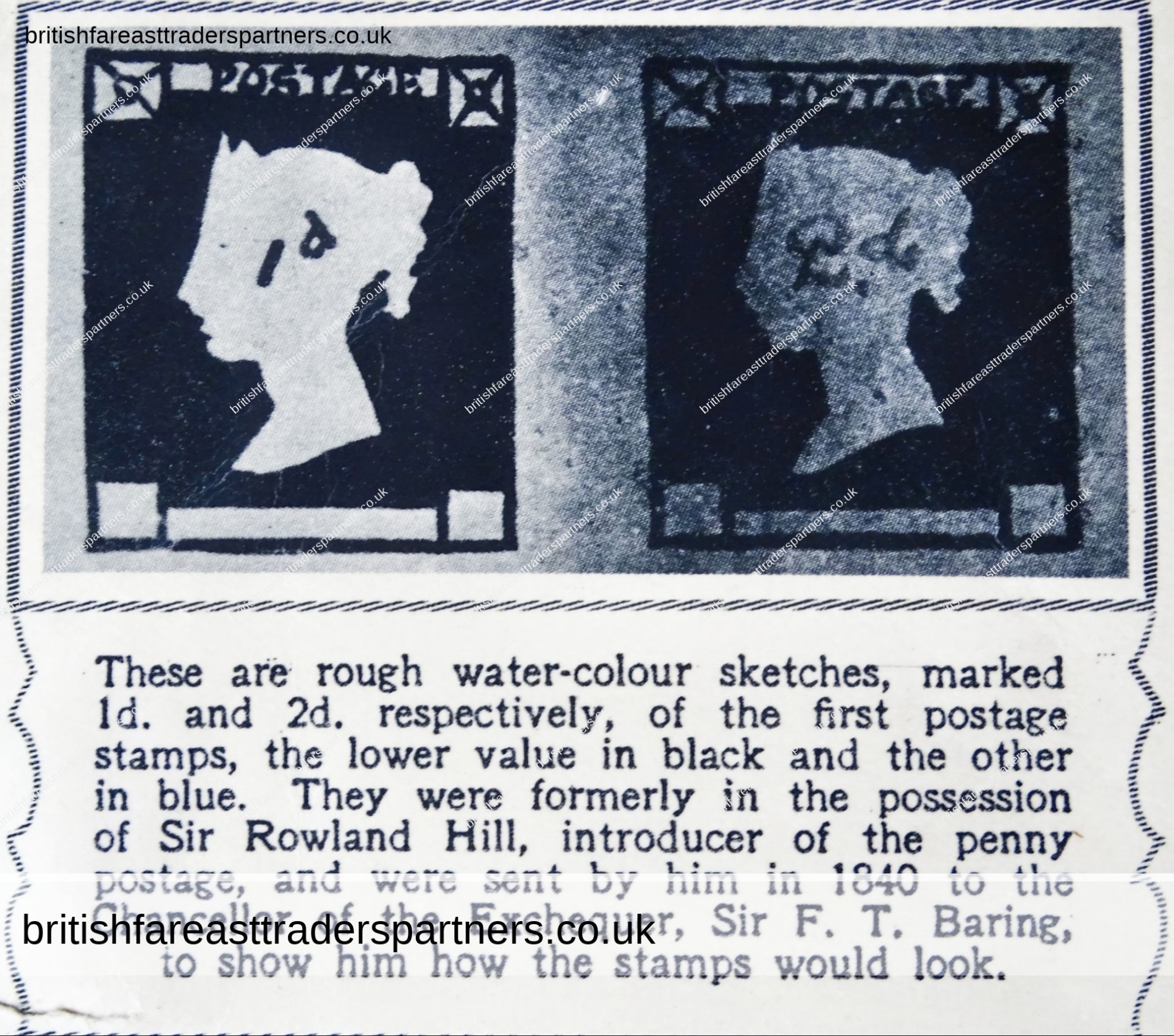
marked 1d. and 2d. respectively,
of the first postage stamps,
the lower value in black and the other in blue.
They were formerly in the possession of Sir Rowland Hill,
introducer of the penny postage,
and were sent by him in 1840
to the Chancellor of the Exchequer,
Sir F.T. Baring,
to show him how the stamps would look.

before our first stamps came into being.
Here is seen (left) a stamp with the Queen’s head,
but with a background which was rejected
in favour of one in the form shown on the right,
but without the head.

without the lettering,
shows the beautiful engraving of the Queen’s profile
and the effective design.
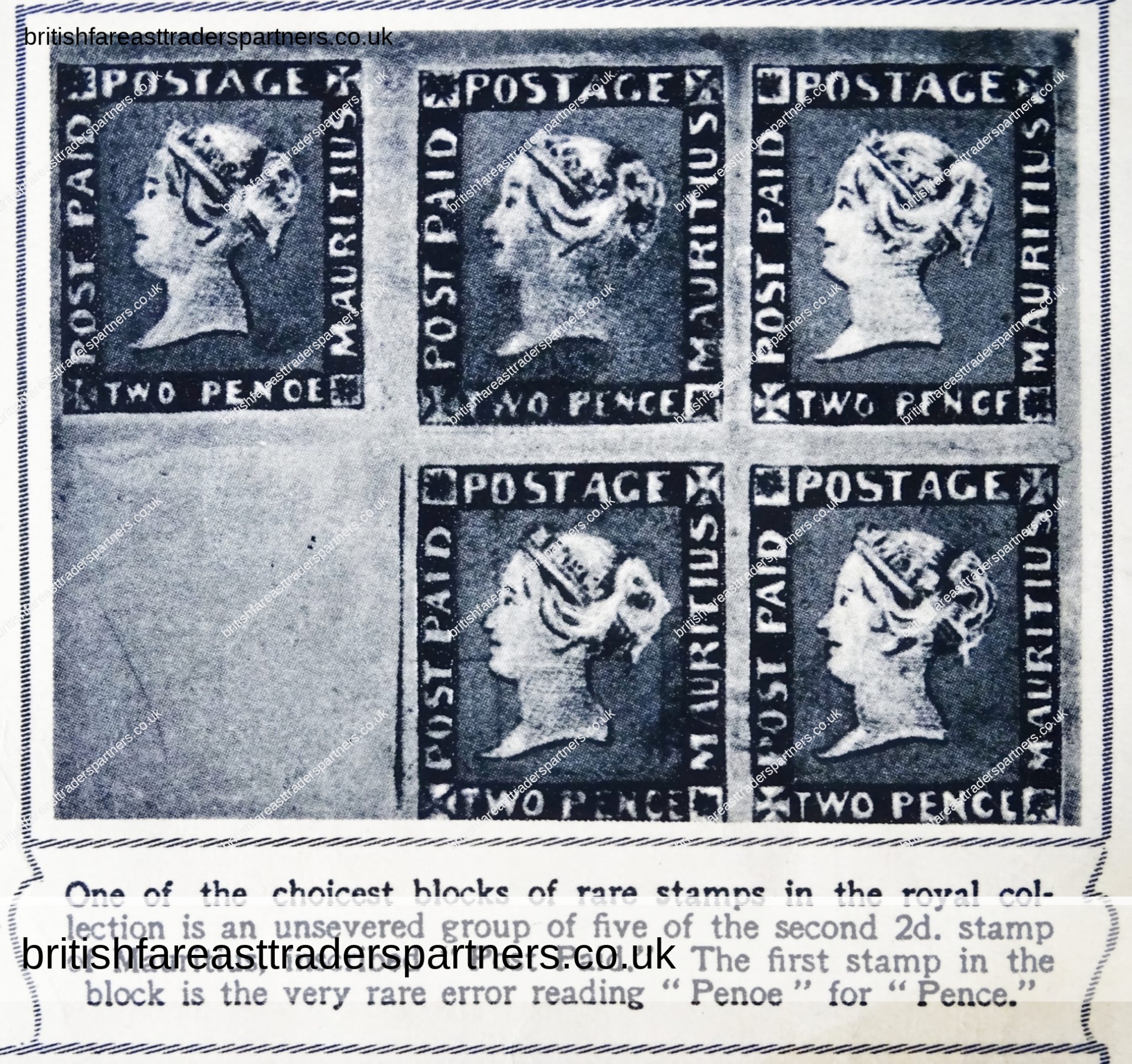
is an unsevered group of five of the second 2d. stamp of Mauritius,
inscribed “Post Paid”
The first stamp in the block is the very rare error
reading “Penoe” for “Pence”.

includes both the historic rarities called the “Post Office” stamps.
The 1d. red is here seen used,
and is still on the original letter on which it was posted
in Mauritius in 1847.
This stamp was formerly in the collection of the late Earl of Kintore.
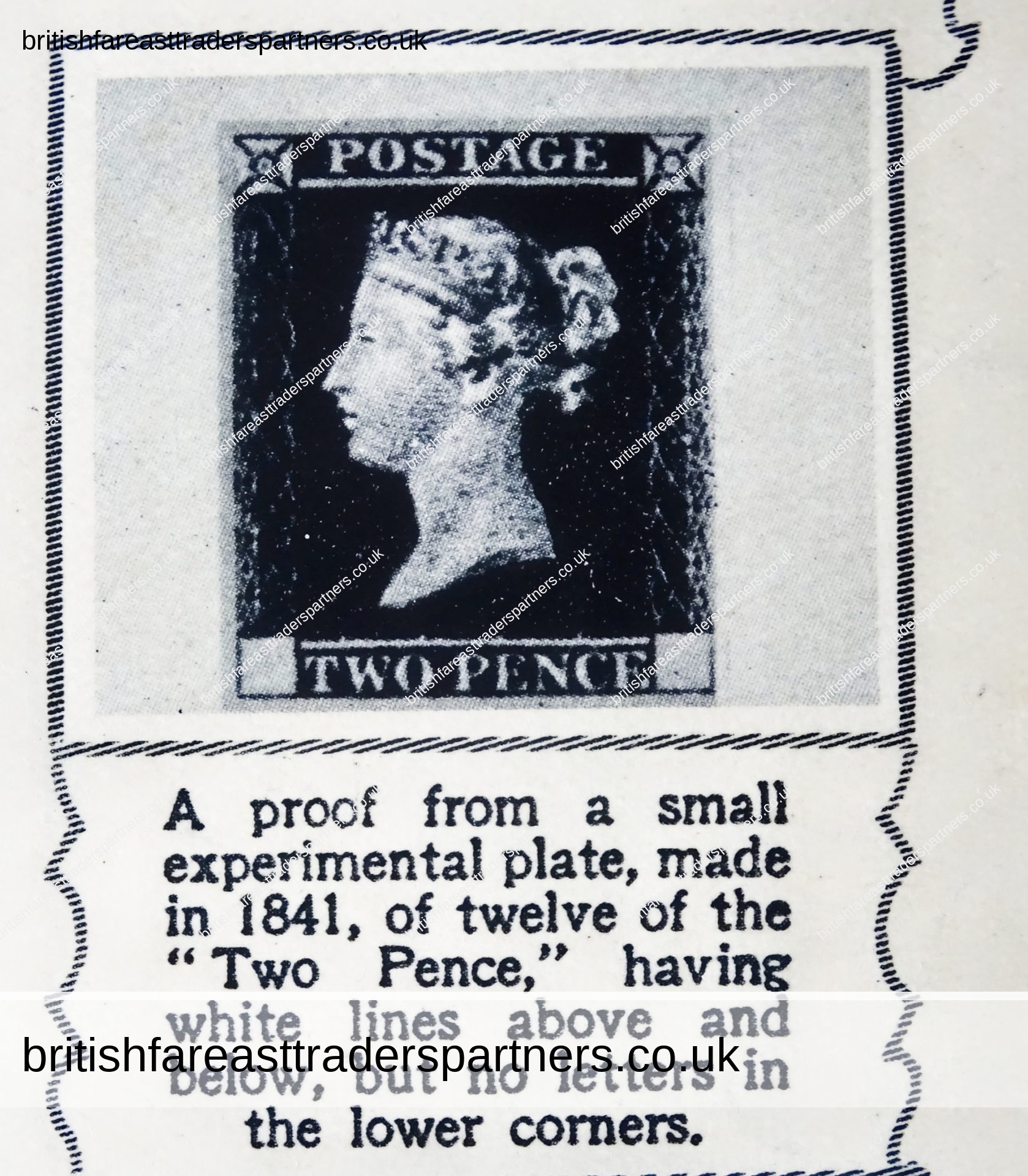
of twelve of the “Two Pence”,
having white lines above and below,
but no letters in the lower corners.
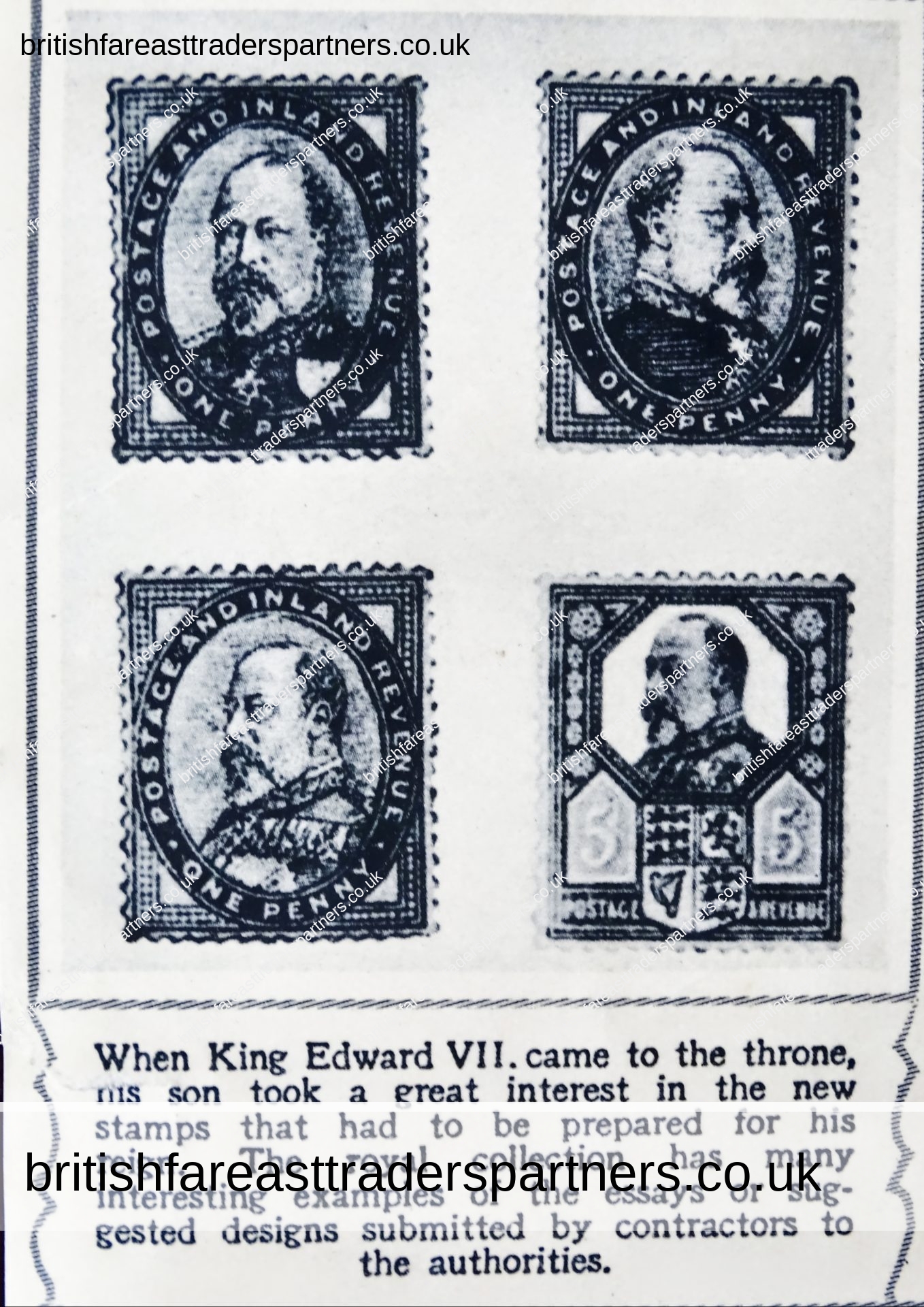
his son took a great interest in the new stamps
that had to be prepared for his reign.
The royal collection has many interesting examples
of the essays or suggested designs
submitted by contractors to the authorities.
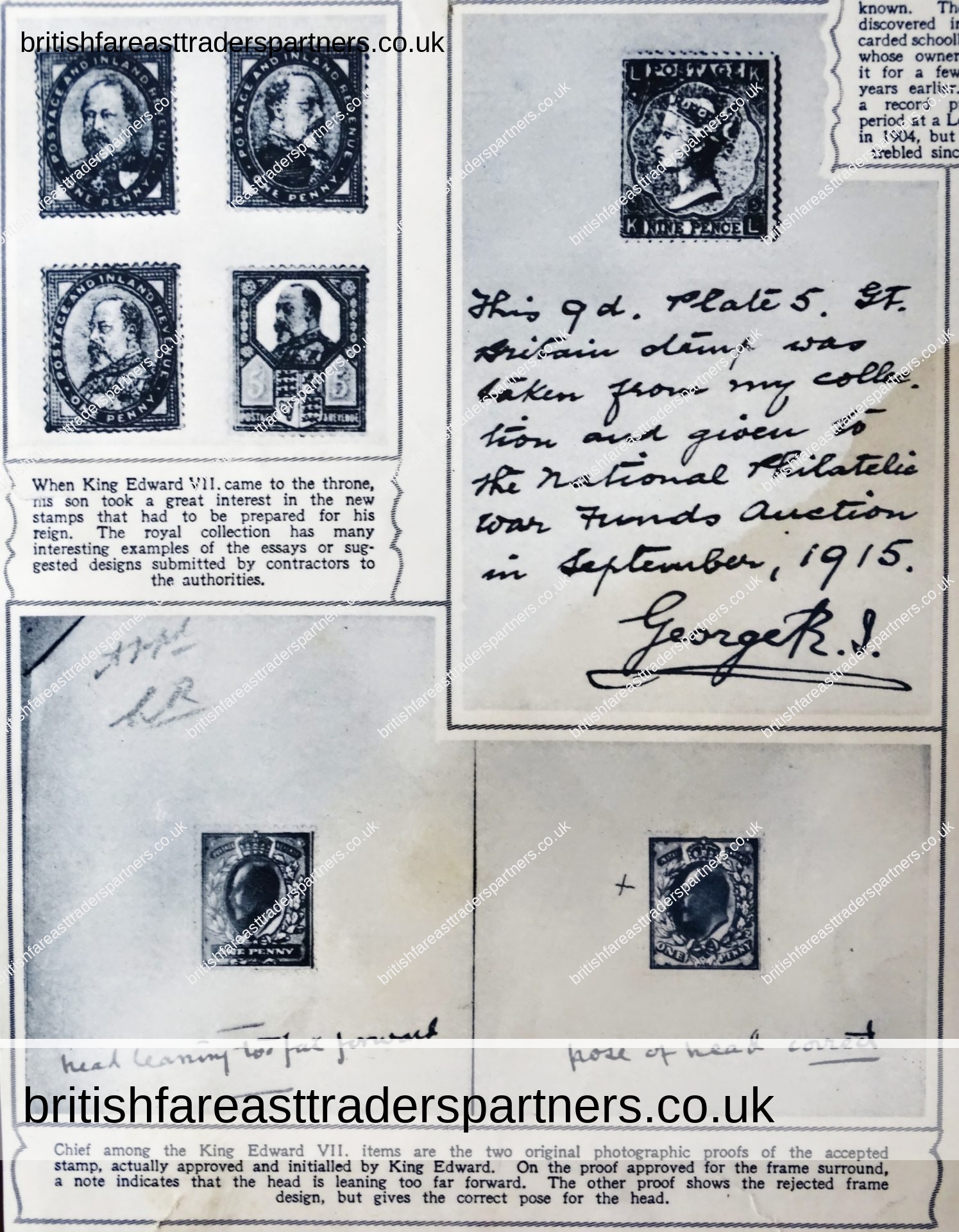
are the two original photographic proofs of the accepted stamp,
actually approved and initialled by King Edward.
On the proof approved for the frame surround,
a note indicates that the head is leaning too far forward.
The other proof shows the rejected frame design,
but gives the correct pose for the head.
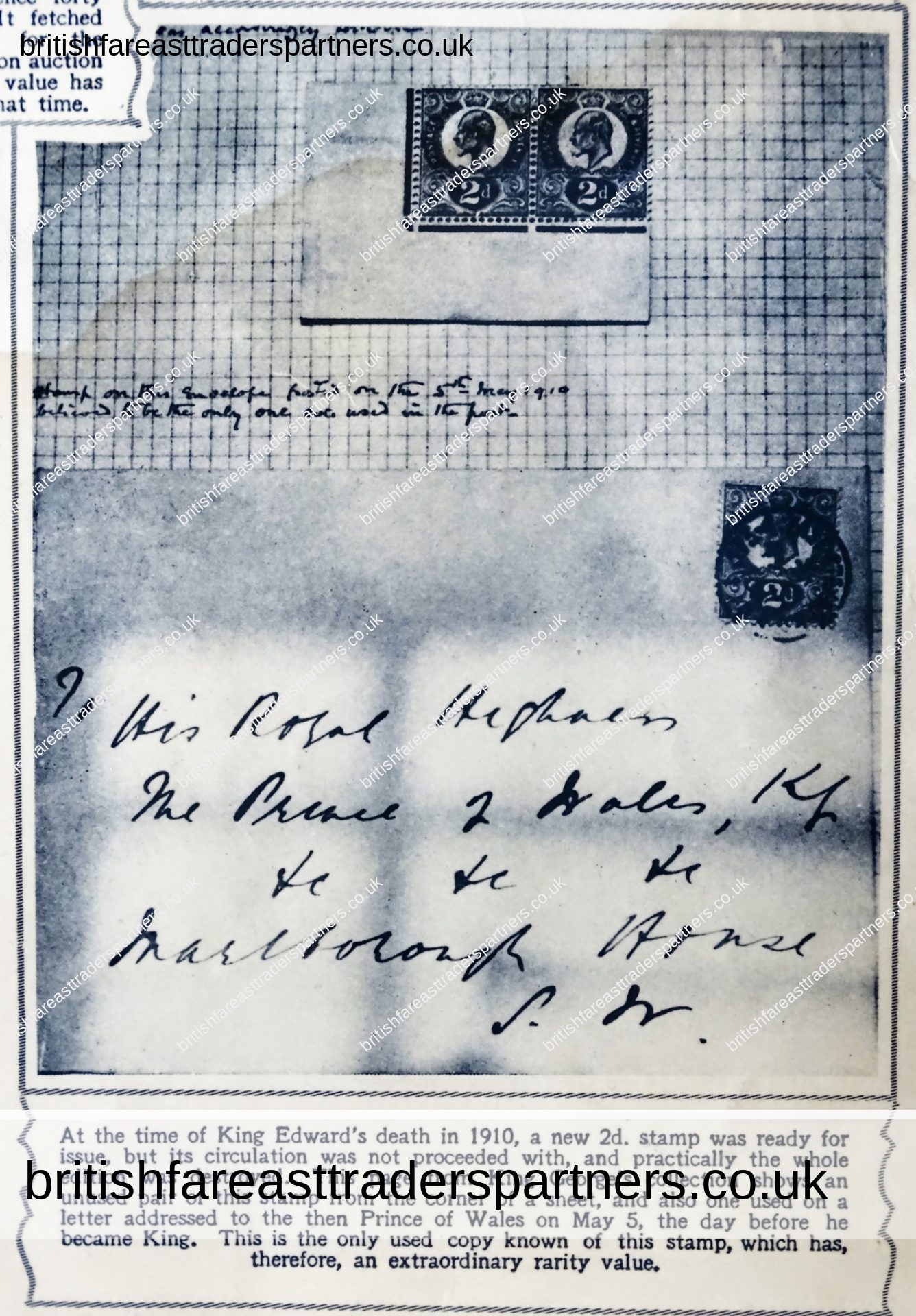
a new 2d. stamp was ready for issue,
but its circulation was not proceeded with,
and practically the whole edition was destroyed.
This page from King George’s collection
shows an unused pair of this stamp from the corner of a sheet,
and also one used on a letter addressed
to the then Prince of Wales on May 5,
the day before he became King.
This is the only used copy known of this stamp,
which has, therefore,
an extraordinary rarity value.
BRITISH & FAR EAST TRADERS LIFESTYLE & SHOPPING BLOG RELATED POSTS:
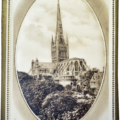 VINTAGE RAPHAEL TUCK & SONS “GOLD FRAMED SEPIA” POSTCARD NO. 1309 NORWICH CATHEDRAL , ENGLAND TOPOGRAPHICAL POSTCARD RAPHAEL TUCK & SONS | CATHEDRALS | BRITISH | HERITAGE | TOPOGRAPHY | HIGHLY COLLECTABLE
VINTAGE RAPHAEL TUCK & SONS “GOLD FRAMED SEPIA” POSTCARD NO. 1309 NORWICH CATHEDRAL , ENGLAND TOPOGRAPHICAL POSTCARD RAPHAEL TUCK & SONS | CATHEDRALS | BRITISH | HERITAGE | TOPOGRAPHY | HIGHLY COLLECTABLE
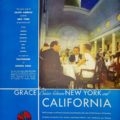 VINTAGE MAY 4, 1935 GRACE CRUISES CRUISES BETWEEN NEW YORK AND CALIFORNIA ILLUSTRATED LONDON NEWS PRINT AD COLLECTABLES / SEA TRANSPORT | NAUTICAL | CRUISE SHIPS | OCEAN LINERS | HOLIDAYS | TOURS & TRAVELS | EPHEMERA
VINTAGE MAY 4, 1935 GRACE CRUISES CRUISES BETWEEN NEW YORK AND CALIFORNIA ILLUSTRATED LONDON NEWS PRINT AD COLLECTABLES / SEA TRANSPORT | NAUTICAL | CRUISE SHIPS | OCEAN LINERS | HOLIDAYS | TOURS & TRAVELS | EPHEMERA
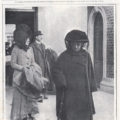 ANTIQUE 1920 “THE LATE EMPRESS EUGENIE” Illustrated London News ARTICLE
ANTIQUE 1920 “THE LATE EMPRESS EUGENIE” Illustrated London News ARTICLE
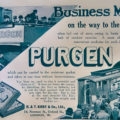 ANTIQUE JULY 1, 1911 ON THE SPHERE PURGEN APERIENT MEDICINE (LAXATIVES) BUSINESSMEN ON THE WAY TO THE CITY H & T KIRBY & CO LTD. 14 NEWMAN ST, OXFORD ST LONDON, W. COLLECTABLE CHEMIST ADVERTISING HERITAGE | CULTURE | HEALTH
ANTIQUE JULY 1, 1911 ON THE SPHERE PURGEN APERIENT MEDICINE (LAXATIVES) BUSINESSMEN ON THE WAY TO THE CITY H & T KIRBY & CO LTD. 14 NEWMAN ST, OXFORD ST LONDON, W. COLLECTABLE CHEMIST ADVERTISING HERITAGE | CULTURE | HEALTH
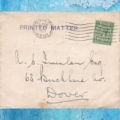 ANTIQUE 1928 COLLECTABLE King GEORGE V GREEN HALFPENNY STAMP KENT ENVELOPE COVER
ANTIQUE 1928 COLLECTABLE King GEORGE V GREEN HALFPENNY STAMP KENT ENVELOPE COVER
 Southampton Holiday Escape: Leonardo Royal Hotel Festive Retreat
Southampton Holiday Escape: Leonardo Royal Hotel Festive Retreat
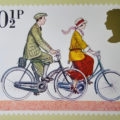 VINTAGE 1978 Cycling First Day of Issue Post Office Picture Card – 1920’s Tourer
VINTAGE 1978 Cycling First Day of Issue Post Office Picture Card – 1920’s Tourer
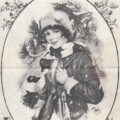 1920 The Spirit of Christmas ARTHUR BUTCHER Illustrated London News PRINT
1920 The Spirit of Christmas ARTHUR BUTCHER Illustrated London News PRINT
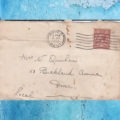 ANTIQUE 1928 COLLECTABLE King GEORGE V THREE HALFPENCE STAMP ENVELOPE COVER
ANTIQUE 1928 COLLECTABLE King GEORGE V THREE HALFPENCE STAMP ENVELOPE COVER
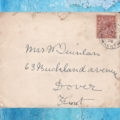 ANTIQUE 1928 COLLECTABLE King GEORGE V THREE HALFPENCE STAMP KENT ENVELOPE COVER
ANTIQUE 1928 COLLECTABLE King GEORGE V THREE HALFPENCE STAMP KENT ENVELOPE COVER
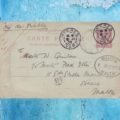 ANTIQUE 1903 POST CARD from HOTEL LES MIMOSAS, HYERES (FRANCE) TO SLIEMA, MALTA
ANTIQUE 1903 POST CARD from HOTEL LES MIMOSAS, HYERES (FRANCE) TO SLIEMA, MALTA
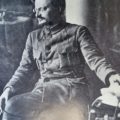 THE HEAD OF THE RED ARMY FROM AN EXCLUSIVE PHOTOGRAPH TREMENDOUSLY POPULAR IN RUSSIA: TROTSKY, PEOPLE’S COMMISSAR FOR WAR THE ILLUSTRATED LONDON NEWS OCTOBER 23,1920 ANTIQUARIAN & COLLECTABLES ARTS | PRINTS HISTORY | MILITARIA SOCIETY PERSONALITIES
THE HEAD OF THE RED ARMY FROM AN EXCLUSIVE PHOTOGRAPH TREMENDOUSLY POPULAR IN RUSSIA: TROTSKY, PEOPLE’S COMMISSAR FOR WAR THE ILLUSTRATED LONDON NEWS OCTOBER 23,1920 ANTIQUARIAN & COLLECTABLES ARTS | PRINTS HISTORY | MILITARIA SOCIETY PERSONALITIES
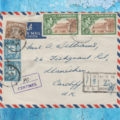 ANTIQUE COLLECTABLE King GEORGE VI JAMAICA STAMPS on AIR MAIL ENVELOPE COVER
ANTIQUE COLLECTABLE King GEORGE VI JAMAICA STAMPS on AIR MAIL ENVELOPE COVER
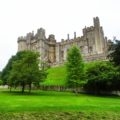 DAYS OUT IN UNITED KINGDOM: PLACES OF INTEREST in WEST SUSSEX, ENGLAND: A SERIES OF PHOTOGRAPHIC BLOG: ARUNDEL CASTLE GROUNDS & ARUNDEL CASTLE WATER GARDEN : A WORLD HERITAGE SITE : HERITAGE | ART | HISTORY | TOPOGRAPHY | TOURISM | TRAVEL | ARCHITECTURE | ARISTOCRACY | CULTURE
DAYS OUT IN UNITED KINGDOM: PLACES OF INTEREST in WEST SUSSEX, ENGLAND: A SERIES OF PHOTOGRAPHIC BLOG: ARUNDEL CASTLE GROUNDS & ARUNDEL CASTLE WATER GARDEN : A WORLD HERITAGE SITE : HERITAGE | ART | HISTORY | TOPOGRAPHY | TOURISM | TRAVEL | ARCHITECTURE | ARISTOCRACY | CULTURE
 VINTAGE 13th MARCH 1940 F. UTTLEY & SON PROSPECT STREET WORKS HUDDERSFIELD TEXTILE MILL FURNISHERS and BOBBIN MAKERS CHROME LEATHER and BUFFALO PICKER MERCHANTS Addressed to Messrs. Fisher , Firth & Co. Ltd. MONTHLY ACCOUNT BILLHEAD / INVOICE COLLECTIBLES/ EPHEMERA / BUSINESS & COMMERCE
VINTAGE 13th MARCH 1940 F. UTTLEY & SON PROSPECT STREET WORKS HUDDERSFIELD TEXTILE MILL FURNISHERS and BOBBIN MAKERS CHROME LEATHER and BUFFALO PICKER MERCHANTS Addressed to Messrs. Fisher , Firth & Co. Ltd. MONTHLY ACCOUNT BILLHEAD / INVOICE COLLECTIBLES/ EPHEMERA / BUSINESS & COMMERCE
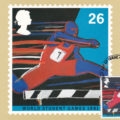 VINTAGE 1991 SPORT ’91 (HURDLING) ROYAL MAIL STAMP CARD SERIES POSTCARD
VINTAGE 1991 SPORT ’91 (HURDLING) ROYAL MAIL STAMP CARD SERIES POSTCARD
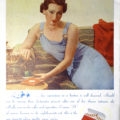 VINTAGE MAY 11, 1935 CRAVEN A Virginia Cigarettes LONDON Illustrated News COLLECTABLE TOBBACIANA / SMOKING ADVERTISEMENT EPHEMERA
VINTAGE MAY 11, 1935 CRAVEN A Virginia Cigarettes LONDON Illustrated News COLLECTABLE TOBBACIANA / SMOKING ADVERTISEMENT EPHEMERA
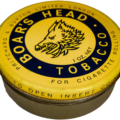 VINTAGE “BOAR’S HEAD TOBACCO” PRITCHARD & BURTON LIMITED LONDON ADVERTISING COLLECTABLE TIN VINTAGE | COLLECTABLES | ADVERTISING | TOBACCIANA | SMOKING SUPPLIES | NOSTALGIA | HERITAGE | LIFESTYLE
VINTAGE “BOAR’S HEAD TOBACCO” PRITCHARD & BURTON LIMITED LONDON ADVERTISING COLLECTABLE TIN VINTAGE | COLLECTABLES | ADVERTISING | TOBACCIANA | SMOKING SUPPLIES | NOSTALGIA | HERITAGE | LIFESTYLE
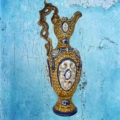 ANTIQUE VICTORIAN MAJOLICA “ALHAMBRIAN” Blue & Brown DECORATIVE EWER JUG VASE
ANTIQUE VICTORIAN MAJOLICA “ALHAMBRIAN” Blue & Brown DECORATIVE EWER JUG VASE
 VINTAGE 1988 “CHARLOTTE NEUVILLE Spring / Summer 1988” LONDON HARRODS Article Ad
VINTAGE 1988 “CHARLOTTE NEUVILLE Spring / Summer 1988” LONDON HARRODS Article Ad
